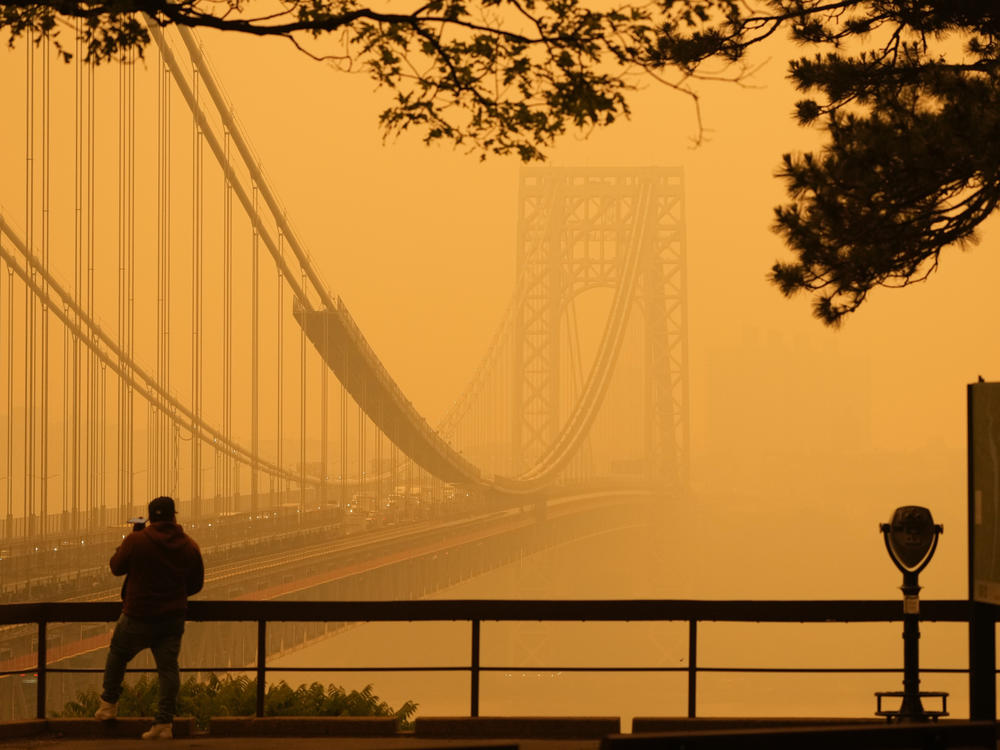Section Branding
Header Content
How to stay safe from the smoke that's spreading from the Canadian wildfires
Primary Content
What is particulate matter? How do I interpret the AQI?
There's a lot to learn since Canadian wildfires suddenly sent clouds of hazy smoke over the border and into parts of the Midwest, Northeast and Mid-Atlantic U.S. this week.
According to the National Weather Service, unhealthy air quality levels are expected to persist in the coastal Northeast on Thursday, before the smoke moves into the interior Northeast and the Ohio Valley on Friday.
Here's a breakdown of some of the more technical wildfire-related terms you might hear and what experts say are some of the best ways to protect yourself and your loved ones.
Particulate matter: the stuff that makes wildfire smoke dangerous
Wildfire smoke, such as what's come over from Canada, contains something called particulate matter.
These are tiny solid and liquid droplets that hang in the air and can be harmful to human health. Wildfires are a major source of particulate matter in the air.
Larger particulate matter (called PM10) can irritate your eyes, nose and throat, according to the Centers for Disease Control and Prevention.
But smaller particulate matter (called PM2.5) is apparently even worse, since the fine particles can get into the deeper parts of your lungs and your blood.
Breathing in wildfire smoke is dangerous, and people with lung and heart problems, the elderly, young children and pregnant people face an even greater risk.
What is the Air Quality Index, or AQI?
You may have seen the air quality in your area described with a number or a color. That's likely the Air Quality Index, or AQI.
This is the measuring system the Environmental Protection Agency uses to explain how safe — or unsafe — the air is in a certain area.
Air quality is quantified using a scale that ranges from zero to 500, with a lower number indicating better air quality and anything over 300 being hazardous.
The numerical scale is broken into sections that are color-coded, making it easier for people to understand the conditions in their area:
- 0-50 is "good" air quality and colored GREEN
- 51-100 is "moderate" and YELLOW
- 101-150 is "unhealthy for certain groups" and ORANGE
- 151-200 is "unhealthy" and RED
- 201-300 is "very unhealthy" and PURPLE
- 301 and above is "hazardous" and MAROON
Particulate matter is one of the pollutants used to derive the AQI.
Tips for keeping you and your loved ones safe
Reduce your exposure to the particulate matter in wildfire smoke by staying indoors as much as possible, wearing an N95 or a similar respirator outside and limiting strenuous activity.
University of Denver professor Alex Huffman told Colorado Public Radio that people can also monitor the air quality around them, use a high-quality air filter in their homes and seal up openings in their doors and windows.
Your four-legged friends are also at risk from wildfire smoke.
According to the American Veterinary Medical Association, pets should stay indoors as much as possible when the air quality is low and take only brief bathroom breaks outside. Birds shouldn't go outside at all when it's smoky.
Keep dogs hydrated and occupied with indoor activities, such as hide-and-seek, fetch and a refresher on basic commands, says Rover.com.
Experts also encourage owners to keep a go bag for their pet — including food, water, medicine, first aid supplies, a leash or harness and toys — in case your family needs to evacuate.
Copyright 2023 NPR. To see more, visit https://www.npr.org.
Bottom Content




